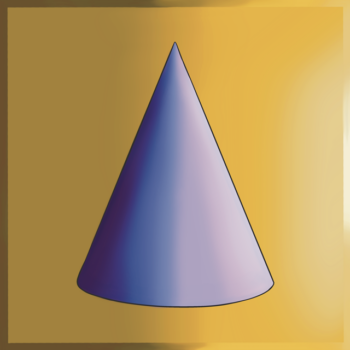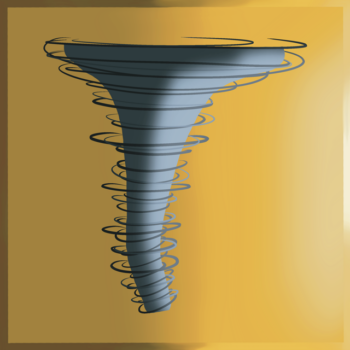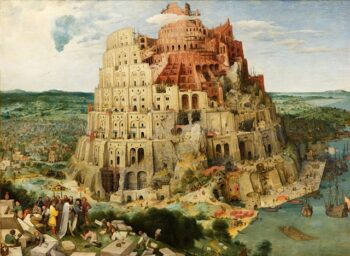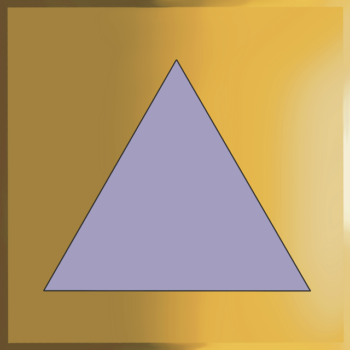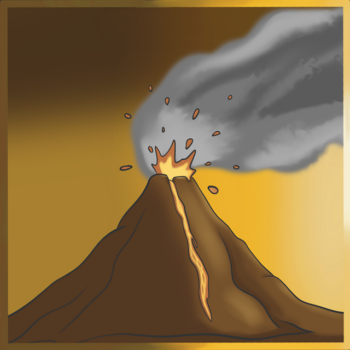
Definition:
A pyramid is a geometric shape with a polygonal base and triangular sides meeting at a single apex.
Etymology:
The term “pyramid” originates from the Greek word “pyramis,” meaning “wheat cake,” “corn bread” or “loaf of bread.” This term was used to describe the shape of the large Egyptian pyramids, which the ancient Greeks likened to bread due to their shape. It was later borrowed into Latin as “pyramis” and eventually into Old French as “piramide” to refer to the geometric figure and the structures it describes.
Description:
The most common pyramid forms include:
- Square pyramid: Has a square base and four triangular sides meeting at a vertex.
- Triangular pyramid: Has a triangular base and three triangular sides meeting at a vertex.
- Rectangular pyramid: Has a rectangular base and four triangular sides meeting at a vertex.
- Hexagonal pyramid: Has a hexagonal base and six triangular sides meeting at a vertex.
However, it is theoretically possible to have a pyramid with any polygonal base, meaning that if the base has enough edges, the pyramid will resemble a cone. It will still maintain the fundamental structure of a pyramid with a flat base and triangular sides.
Pyramids have been constructed and utilized worldwide throughout history, serving as architectural structures, tombs, and symbolic monuments. They are often associated with ancient civilizations such as the ancient Egyptians and the Mesoamerican cultures.
Articles:
Capitalism (The Global Monetary System)
Definition: Capitalism is a belief that ownership exists and how it can be improved. Capitalism is most commonly defined as an economic system characterized by private ownership of the means…
Hierarchy
Definition: “Hierarchy” is a structure that categorizes units or individuals based on relative levels of authority, power, or importance. Etymology: The word “hierarchy” originates from the Greek word “hierarkhia,” composed…
Symbolism:
A pyramid is a classic symbol of hierarchy. As a solid structure with a broad base tapering towards the top, a pyramid represents a structure where most entities or individuals are at the lower levels, while the authority or the main category is concentrated at the top.
In the opening scene of the movie “Despicable Me (2010),” a tourist family gets off the bus to see the Great Pyramid of Giza. While the parents are distracted taking photos, the young boy runs up the scaffold to play at heights with his airplane toy. He gets chased by two security guards as he is not allowed to climb the scaffold. The boy becomes scared and backs up so much that he falls off the scaffold and lands on the pyramid, which turns out to be inflatable. The news anchor on TV makes a pyramid hand gesture while saying that some villain has stolen the pyramid. The entire scene hints at the pyramid being a symbol of a lie. Click to watch the video clip.
The logo of Volkswagen consists of three upside-down pyramids.

Articles:
A
Definition: The letter “A” is the first letter of many alphabets, including but not limited to the modern English alphabet. Etymology: The symbol for the letter “A” originates from the…
Christmas Tree
Definition: A “Christmas tree” is an evergreen tree, often a fir, spruce, or pine, decorated with lights, ornaments, tinsel, and other Christmas decorations. Etymology: The term “Christmas tree” combines “Christmas,”…
Cone
Definition: A cone is a geometric figure with a circular base that tapers evenly to a single point, called the apex. Etymology: The word “cone” originates from the Latin word…
Dunce Cap
Definition: A “dunce cap” is a tall conical hat historically used as a form of punishment in schools. Etymology: The term “dunce” originates from the name of John Duns Scotus,…
Ice Cream Cone
Definition: An ice cream cone is a conical-shaped edible container typically made from a crispy baked or molded material, such as waffle, wafer, or sugar cone. An ice cream cone…
Illuminati
Definition: “Illuminati” refers to individuals who understand how language, religion, and the world system are scams. Etymology: The term “Illuminati” originates from Latin and means “the enlightened.” It is derived…
Ku Klux Klan’s Hood
Definition: Ku Klux Klan’s white hood is a symbol associated with the Ku Klux Klan, a white supremacist hate group in the United States of America. Etymology: The Ku Klux…
Megaphone
Definition: A megaphone is a device used to amplify sound. Etymology: The word “megaphone” comes from the Greek words “mega” (meaning “great” or “large”) and “phone” (meaning “voice” or “sound”)….
Mountain
Definition: A “mountain” is a large natural elevation of the earth’s surface that rises steeply from the surrounding level. Mountains are formed through geological processes such as plate tectonics, volcanic…
Party Hat
Definition: A “party hat” is a festive accessory typically worn at celebrations such as birthdays, New Year Transition, and other joyous events. Etymology: The term “party hat” combines “party,” which…
Pine Cone
Definition: Pine cones, also known as conifer cones, are seed-bearing structures produced by pine trees. Etymology: The term “pine cone” comes from the Old English “pīn,” meaning “pine tree,” and…
Santa Hat
Definition: A “Santa hat” is a festive piece of headwear typically worn during the Christmas season. Etymology: The term “Santa hat” is derived from “Santa Claus,” the popular figure associated…
The Great Seal of the United States of America
Definition: The Great Seal of the United States is a national seal that symbolizes the authority and sovereignty of the federal government. Description: The Great Seal was adopted by the…
Three (3)
Definition: The number “3” is the third natural number following “2” and preceding “4.” It represents a quantity of three units or objects. Etymology: The etymology of the number “3”…
Tornado
Definition: A “tornado” is a rapidly rotating column of air that extends from a thunderstorm to the ground. It is characterized by its funnel shape and intense winds, which can…
Tower Cake
Definition: A “kransekake,” meaning “wreath cake”, also known as a “tower cake,” is a Danish and Norwegian traditional cake made of almonds, sugar, and egg whites. Etymology: The term “tower…
Tower of Babel
Pieter Bruegel the Elder: The Tower of Babel (1563). Lucas van Valckenborch: Tower of Babel (1594). Gustave Doré: The Confusion of Tongues. Definition: “Babel’s Tower” is a fictional tower from…
Tree
Definition: A tree is a large perennial plant that typically has a trunk supporting branches and leaves. Etymology: The word “tree” comes from the Old English “trēow,” which is related…
Triangle
Definition: A triangle is a geometric figure consisting of three lines that meet at three corners, also called angles or vertices. The sum of the three angles in a triangle…
Volcano
Definition: A “volcano” is a geological formation, typically a mountain, where molten rock (magma), ash, and gases from the Earth’s interior erupt through the Earth’s crust. Etymology: The word “volcano”…
Wedding Cake
Definition: A “wedding cake” is a special cake served at a wedding reception following the wedding ceremony. It is often multi-tiered, elaborately decorated, and designed to reflect the couple’s tastes…
Witch’s Hat
Definition: A witch’s hat is a hat worn by a witch. It’s typically a tall pointed, cone-shaped black hat with a wide brim. Etymology: The term “witch” comes from the…
Wizard’s Hat
Definition: A wizard’s hat is a hat worn by a wizard. It’s typically a tall pointed, cone-shaped hat with a wide brim, adorned with stars, moons, or other mystical symbols….
The Pyramids of Giza:
Claimed Reason for Building the Pyramids of Giza:
The ancient Egyptians believed that the pharaohs would ascend to the stars after death. Some texts, such as the Pyramid Texts, describe the king’s journey to the stars and the belief that the king would join the circumpolar stars, which were considered immortal because they never set.
The most widely accepted theory among Egyptologists is that the pyramids were built as monumental tombs for pharaohs. They claimed that the pyramids served as a means to ensure the pharaoh’s safe passage to the afterlife. That the elaborate construction and orientation of the pyramids were designed to honor the gods and secure the pharaoh’s eternal life.
Astronomical Alignments:
One of the most popular theories is the “Orion Correlation Theory,” proposed by Robert Bauval. This theory suggests that the three pyramids of Giza were constructed to align with the three stars in Orion’s Belt. According to this theory: The pyramids represent the stars of Orion’s Belt, which were associated with Osiris, the ancient Egyptian god of the afterlife. This alignment was intended to serve as a guide for the souls of the pharaohs to reach the afterlife, specifically to join Osiris in the constellation of Orion.
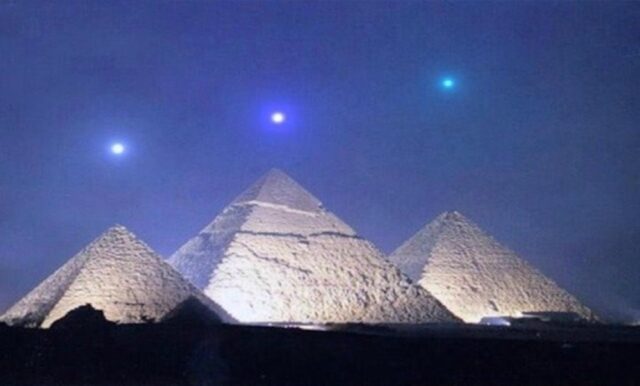
It is claimed that the stars of Orions Belt will align above the pyramids of Giza every 2,737 year. And many sources claim that this image is authentic. But it is most certainly not authentic. Given the amount of light pollution typically present around Cairo, the stars in the sky, even on a clear night, would not usually appear as distinctly and brightly as shown in the image. The alignment would not typically be visible in such a clear and obvious way from Earth, especially in a single photograph. The three lights in the sky appear unnaturally bright and colored. Stars, including those in Orion’s Belt, do not typically appear this vividly colored or bright in the night sky in photos without long exposure and specific photographic techniques.

Image of Orion’s Belt (the three bright stars).
The astronomical alignments of Pyramids of Giza in Egypt with Orion’s Belt can also be considered for the Teotihuacan Pyramids in Mexico and the Pyramids near Xi’an in China as well.
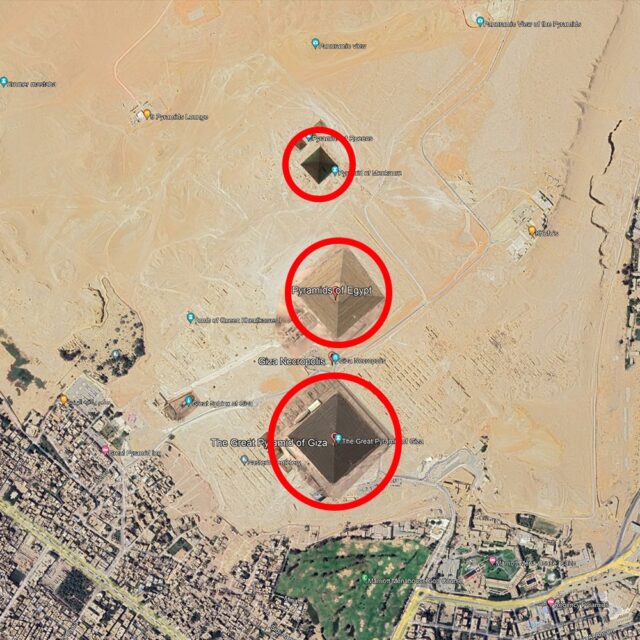
Image of the pyramids of Giza in Egypt.
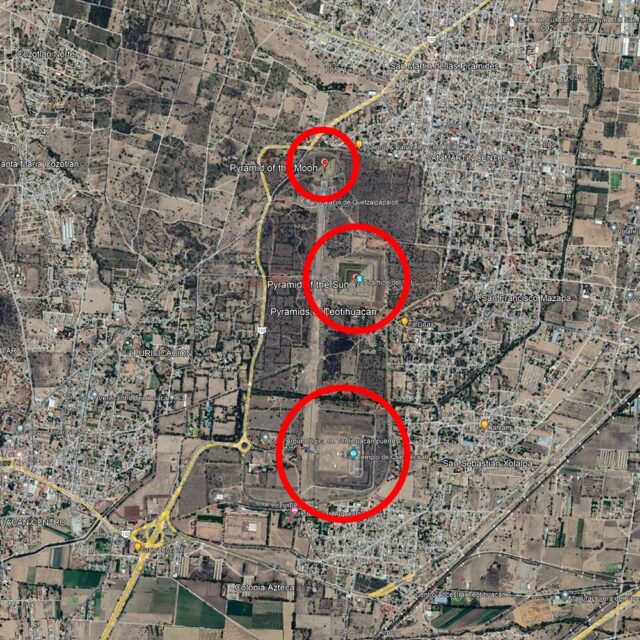
Image of the pyramids of Teotihuacan in Mexico.
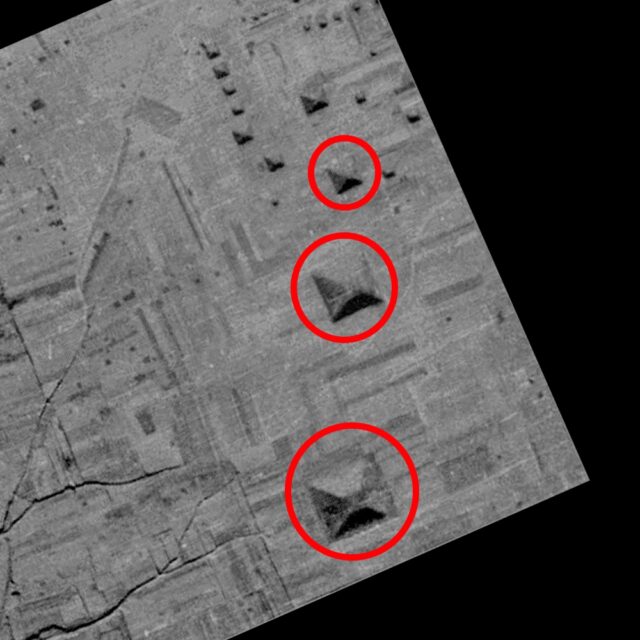
Image of three of the pyramids of Xi’an in China.
The astronomical alignments with Orion’s Belt can also be considered for the World Trade Center Memorial in USA.
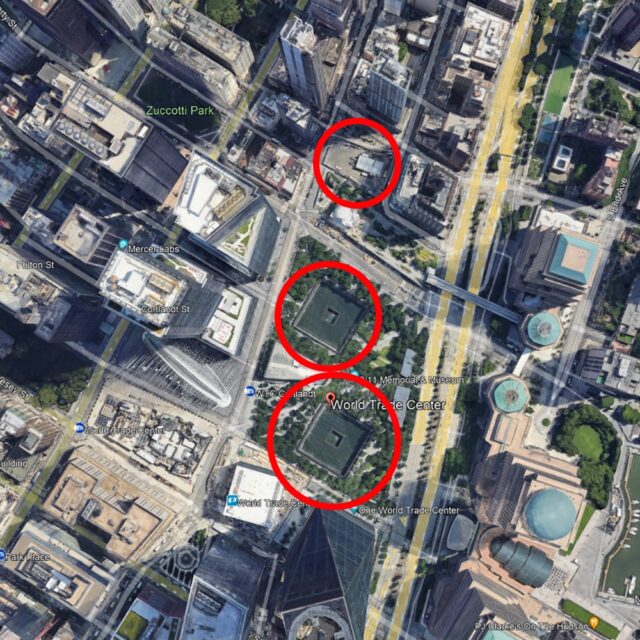
Image of the World Trade Center Memorial in Manhattan, New York in USA.
Another theory relates to the pyramids and their alignment with the sun: The layout of the pyramids might have been intended to mirror the heliacal rising of certain stars and the sun’s path. The sun was a major deity in ancient Egyptian religion, often associated with the god Ra. The positioning and angles of the pyramids could be interpreted as a reflection of the Egyptians’ understanding of solar cycles and their desire to align their monuments with significant solar events, such as solstices.
This is of course a fictional story, as Gods and eternal life are fictional concepts. Making the pyramids of Giza great stories of deception.
How the Pyramids of Giza Were Built:
The exact methods used to build the Pyramids of Giza are still a subject of debate among historians and archaeologists. This has led many conspiracy theorists to straight up claim it must have been made by aliens. However, there are several widely accepted theories based on historical records, archaeological evidence, and engineering studies. Here are some of the main theories about how they were constructed:
- Limestone Quarries and Transportation: Most of the limestone blocks used in the pyramids were quarried locally from the Giza plateau itself. The massive blocks were likely transported using sledges, rollers, and possibly lubrication with water to reduce friction. Water might have been used to wet the sand in front of the sledges, making it easier to drag the stones.
- Ramp Theories: Several ramp theories have been proposed to explain how the heavy stones were lifted into place:
- Straight Ramp: A long, straight ramp leading up to the construction site. This would have required a massive amount of material and would become impractically long as the pyramid grew taller.
- Zigzagging or Switchback Ramps: Ramps that zigzagged up the sides of the pyramid. These would have been shorter and required less material but would have been more complex to build.
- Spiral Ramps: Ramps that spiraled around the pyramid as it rose. This theory is supported by some evidence and would have allowed workers to move the stones up gradually.
- Internal Ramp Theory: Proposed by French architect Jean-Pierre Houdin, this theory suggests that the pyramid was built using a spiral ramp inside the structure. The ramp would have been dismantled and incorporated into the pyramid as construction progressed.
- Lever Systems: Levers and counterweights may have been used to lift the stones. Workers could have used wooden levers to lift the blocks a few feet at a time, placing small stones or wooden supports underneath and repeating the process.
- Labor Force: It’s suggested that a large, well-organized workforce of skilled laborers, rather than slaves, built the pyramids. These workers lived in nearby temporary cities and were well-fed and cared for. Excavations of worker camps have revealed barracks, bakeries, breweries, and medical facilities, indicating a highly organized effort.
- Project Management and Logistics: The construction of the pyramids would have required meticulous planning and management. This included quarrying, transporting, and placing millions of stone blocks, as well as organizing labor, food, and supplies for the workers.
- Tools and Techniques: Workers used copper chisels, saws, and drills to cut the stone blocks. Harder stones like granite were worked using dolerite pounders. The ancient Egyptians had advanced knowledge of mathematics and astronomy, which they used to align the pyramids with great precision. The Great Pyramid, for example, is aligned almost perfectly with the cardinal points.
- Transportation with Water: In 2013, the discovery of the “Diary of Merer,” a logbook of an overseer involved in the construction of the Great Pyramid, provided new insights. It describes the transportation of limestone blocks from Tura to Giza along the Nile and the construction logistics.
The Claim That the Pyramids of Giza Were Built by Slaves:
The claim that the Pyramids of Giza were built by slaves primarily originates from ancient historical sources and has been perpetuated by popular culture over the centuries.
The Greek historian Herodotus, writing in the 5th century BCE, is one of the earliest sources to mention the construction of the pyramids. He reported that the pyramids were built by 100,000 slaves who worked in shifts, although his accounts are considered to be a mix of observation, hearsay, and myth.
The story of the Israelites being enslaved in Egypt, as recounted in the Bible, has also contributed to the perception that the pyramids were built by slaves. While the Bible does not explicitly link the Israelites to the construction of the pyramids, the association has been made in popular interpretations.
Modern archaeological claim to have evidence that has largely debunked the notion that the pyramids were built by slaves. Key findings include:
- Workers‘ Villages: Excavations have uncovered remains of workers‘ villages near the pyramids, complete with evidence of well-organized living quarters, food supplies, and medical care. These findings suggest that the workers were skilled laborers and artisans who were well-fed and cared for, rather than slaves.
- Graffiti and Inscriptions: Graffiti and inscriptions found in the pyramids and surrounding areas often contain the names of work crews, which were organized into teams with names like “Friends of Khufu” or “Drunkards of Menkaure.” These suggest a sense of pride and camaraderie among the workers, which they claim is inconsistent with the idea of forced slave labor.
- Evidence of Skilled Labor: The precision and complexity of the construction techniques indicate that the workers were highly skilled and knowledgeable about engineering and stonework.
Reason Why the Pyramids of Giza Were Built:
It is important to actually understand the definition of a slave. A slave is a person who works only to afford essential necessities, such as food, clothes, medicine and shelter. It is not the lack of essential necessities that define a person as a slave.
The story the workers were given to why they were to build the pyramids is a fictional story. What they were promised was a lie. Meaning that their work was literally for nothing.
Many ask why they built the pyramids. And the pyramids of Giza has become known as one of history’s biggest mysteries. Though it is quite obvious that mystery is the meaning of the project. The installment of asking for meaning is what’s called implementation of SLM (Islam). The pyramids were designed to demonstrate the ability to trick people to waste their time for something meaningless. The meaning is that there is no meaning, and that people will look for meaning where meaning does not exist.










